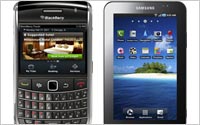Commentary
Killing 'Mobile' Advertising To Live Smarter Second Lives
- by Steve Smith , Staff Writer @popeyesm, January 14, 2013
 It only took a few months of having the
iPad in the device market for marketers to mention offhandedly that tablets really weren’t “mobile.” The use case and behaviors were very different between tablets and smartphones.
Clearly, the midsized screens were tapping into a different mode among users -- perhaps one that no one ever fully anticipated -- a kind of lean-in-lean-back.
It only took a few months of having the
iPad in the device market for marketers to mention offhandedly that tablets really weren’t “mobile.” The use case and behaviors were very different between tablets and smartphones.
Clearly, the midsized screens were tapping into a different mode among users -- perhaps one that no one ever fully anticipated -- a kind of lean-in-lean-back.
And yet several years later we still use the umbrella term of “mobile” to account for what is now a wide range of screens. Perhaps not much longer. In an especially good end-of-year prediction Deloitte argues that 2013 would be the year we finally start killing off the term "mobile" advertising and replace it more sensibly with tablet advertising segmented out from smartphone advertising. This should be the last year we lump together those revenue reports, says Paul Lee, head of research, Technology, Media & Telecommunications. Smartphones will render about $4.8 billion in 2013 and tablets will earn about $3.5 billion.
There are numerous differences between those similar numbers, however. Smartphones are working off of a massive installed base of about 1.9 billion and 270 million tablets by the end of the year. The phones are rendering $2.30 per device, but tablets will be at almost 3X or $7.50.
The revenues will also break down very differently on devices according to advertising category. Deloitte is expecting massively higher spends when it comes to search and display on tablet versus smartphones. For display especially, the size of the larger screen allows for combinations of messaging and image that mobile cannot imagine, at least within the banner. Lee sees an upside for ad revenue from phones more on the search side, especially as the networks improve and allow users to expect more satisfying click-throughs on results. Tablets, on the other hand -- with both screen size and tremendous upside in scale ahead of them -- look to be the cash cow of mobile going forward.
I think one downside of the overdue separation of smartphone and tablet ad markets is that the allure and success of the latter unfairly ghetto-izes the former. The common complaint that a smartphone micro banner is a nigh-invisible messaging vehicle is understandable on the face of it, but only on the face of it. Interstitials and expandable units can have real impact when well-positioned on the phone page and when the user is confident it will not ruin the app or site experience. What the smartphone lacks in sheer size it gains in intimacy, user focus and sheer share of voice allowed the advertiser. And as a messaging device, there simply is no other that is as reliable, persistent and personal as the smartphone.
For creative, and no doubt for agency billing departments, the tablet may represent the device for which they have been waiting. I will be the first to argue, as I have before, that the tablet is the Web we always wanted. But the creative possibilities aligned with the true “mobility” of the smartphone should not be obscured by the brighter light of the larger screen.




I agree. This has been a challenge for us over the years being grouped into the "mobile" group. Advertisers and agencies for the past year have looked at the CPM rates as equal to those of smart phones. I've been advocating a clear separation with our clients and found success. Our data suggests the tap through rates could easily quadruple the rates of smartphones especially in an app like ours that runs 24/7, in a hotel lobby, made to interact with guests. I personally cant wait for the official transformation.